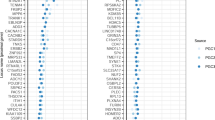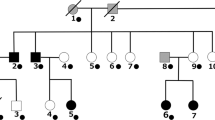Abstract
We previously identified 18q21–q22 as a candidate region for bipolar (BP) disorder and constructed a yeast artificial chromosome (YAC) contig map. Here we identified three potential CpG islands using CCG/CGG YAC fragmentation. Analysis of available genomic sequences using bioinformatic tools identified an exon of 3639 bp downstream of a CpG island of 1.2 kb containing a putative transcription initiation site. The exon contained an open reading frame coding for 1212 amino acids with significant homology to the SART-2 protein; weaker homology was found with a series of sulphotransferases. Alignment of cDNA sequences of corresponding ESTs and RT-PCR sequencing predicted a transcript of 9.5 kb which was confirmed by Northern blot analysis. The transcript was expressed in different brain areas as well as in multiple other peripheral tissues. We performed an extensive mutation analysis in 113 BP patients. A total of nine single nucleotide polymorphisms (SNPs) were identified. Five SNPs predicted an amino acid change, of which two were present in BP patients but not in 163 control individuals.
This is a preview of subscription content, access via your institution
Access options
Subscribe to this journal
Receive 12 print issues and online access
$259.00 per year
only $21.58 per issue
Buy this article
- Purchase on Springer Link
- Instant access to full article PDF
Prices may be subject to local taxes which are calculated during checkout




Similar content being viewed by others
References
Berrettini WH, Ferraro TN, Goldin LR, Weeks DE, Detera-Wadleigh S, Nurnberger Jr JI et al. Chromosome 18 DNA markers and manic-depressive illness: evidence for a susceptibility gene. Proc Natl Acad Sci USA 1991; 91: 5918–5921.
Stine OC, Xu J, Koskela R, McMahon FJ, Gschwend M, Friddle C et al. Evidence for linkage of bipolar disorder to chromosome 18 with a parent-of-origin effect. Am J Hum Genet 1995; 57: 1384–1394.
Maier W, Hallmayer J, Zill P, Bondy B, Lichtermann D, Ackenheil M et al. Linkage analysis between pericentrometric markers on chromosome 18 and bipolar disorder: a replication test. Psychiatry Res 1995; 59: 7–15.
Detera-Wadleigh SD, Badner JA, Berrettini WH, Yoshikawa T, Goldin LR, Turner G et al. A high-density genome scan detects evidence for a bipolar-disorder susceptibility locus on 13q32 and other potential loci on 1q32 and 18p11.2. Proc Natl Acad Sci USA 1999; 96: 5604–5609.
McMahon FJ, Hopkins PJ, Xu J, McInnis MG, Shaw S, Cardon L et al. Linkage of bipolar affective disorder to chromosome 18 markers in a new pedigree series. Am J Hum Genet 1997; 61: 1397–1404.
De Bruyn A, Souery D, Mendelbaum K, Mendlewicz J, Van Broeckhoven C . Linkage analysis of families with bipolar illness and chromosome 18 markers. Biol Psychiatry 1996; 39: 679–688.
Nothen MM, Cichon S, Rohleder H, Hemmer S, Franzek E, Fritze J et al. Evaluation of linkage of bipolar affective disorder to chromosome 18 in a sample of 57 German families. Mol Psychiatry 1999; 4: 76–84.
Turecki G, Grof P, Cavazzoni P, Duffy A, Grof E, Martin R et al. Lithium responsive bipolar disorder, unilineality, and chromosome 18: a linkage study. Am J Med Genet 1999; 88: 411–415.
Coon H, Jensen S, Hoff M, Holik J, Plaetke R, Reimherr F et al. A genome-wide search for genes predisposing to manic-depression, assuming autosomal dominant inheritance. Am J Hum Genet 1993; 52: 1234–1249.
Freimer NB, Reus VI, Escamilla MA, McInnes LA, Spesny M, Leon P et al. Genetic mapping using haplotype, association and linkage methods suggests a locus for severe bipolar disorder (BPI) at 18q22–q23. Nat Genet 1996; 12: 436–441.
Ewald H, Wang AG, Vang M, Mors O, Nyegaard M, Kruse TA . A haplotype-based study of lithium responding patients with bipolar affective disorder on the Faroe Islands. Psychiatr Genet 1999; 9: 23–34.
Van Broeckhoven C, Verheyen GR . Report of the chromosome 18 workshop. Am J Med Genet 1999; 88: 263–270.
Verheyen GR, Villafuerte SM, Del-Favero J, Souery D, Mendlewicz J, Van Broeckhoven C et al. Genetic refinement and physical mapping of a chromosome 18q candidate region for bipolar disorder. Eur J Hum Genet 1999; 7: 427–434.
McInnis MG, McMahon FJ, Chase GA, Simpson SG, Ross CA, DePaulo JRJ . Anticipation in bipolar affective disorder. Am J Hum Genet 1993; 53: 385–390.
Nylander PO, Engstrom C, Chotai J, Wahlstrom J, Adolfsson R . Anticipation in Swedish families with bipolar affective disorder. J Med Genet 1994; 31: 686–689.
Maroglis RL, McInnis MG, Rosenblatt A, Ross CA . Trinucleotide repeat expansion and neuropsychiatric disease. Arch Gen Psychiatry 1999; 56: 1019–1031.
Schalling M, Hudson TJ, Buetow KH, Housman DE . Direct detection of novel expanded trinucleotide repeats in the human genome. Nat Genet 1993; 4: 135–139.
Lindblad K, Nylander PO, De bruyn A, Souery D, Zander C, Engstrom C et al. Detection of expanded CAG repeats in bipolar affective disorder using the repeat expansion detection (RED) method. Neurobiol Dis 1995; 2: 55–62.
O'Donovan MC, Guy C, Craddock N, Murphy KC, Cardno AG, Jones LA et al. Expanded CAG repeats in schizophrenia and bipolar disorder. Nat Genet 1995; 10: 380–381.
O'Donovan MC, Guy C, Craddock N, Bowen T, McKeon P, Macedo A et al. Confirmation of association between expanded CAG/CTG repeats and both schizophrenia and bipolar disorder. Psychol Med 1996; 26: 1145–1153.
Oruc L, Lindblad K, Verheyen GR, Ahlberg S, Jakovljevic M, Ivezic S et al. CAG repeat expansions in bipolar and unipolar disorders. Am J Hum Genet 1997; 60: 730–732.
Lindblad K, Nylander PO, Zander C, Yuan QP, Stahle L, Engstrom C et al. Two commonly expanded CAG/CTG repeat loci: involvement in affective disorders? Mol Psychiatry 1998; 3: 405–410.
Verheyen GR, Del-Favero J, Mendlewicz J, Lindblad K, Van Zand K, Aalbregtse M et al. Molecular interpretation of expanded RED products in bipolar disorder by CAG/CTG repeats located at chromosomes 17q and 18q. Neurobiol Dis 1999; 6: 424–432.
Guy CA, Bowen T, Jones I, McCandless F, Owen MJ, Craddock N et al. CTG18.1 and ERDA-1 CAG/CTG repeat size in bipolar disorder. Neurobiol Dis 1999; 6: 302–307.
Vincent JB, Petronis A, Strong E, Parikh SV, Meltzer HY, Lieberman J et al. Analysis of genome-wide CAG/CTG repeats, and at SEF2-1B and ERDA1 in schizophrenia and bipolar affective disorder. Mol Psychiatry 1999; 4: 229–234.
Goossens D, Del-Favero J, Van Broeckhoven C . Trinucleotide repeat expansions: do they contribute to bipolar disorder? Brain Res Bull 2001; 56: 243–257.
Goossens D, Villafuerte SM, Tissir F, Van Gestel S, Claes S, Souery D et al. No evidence for the involvement of CAG/CTG repeats from within 18q21.33–q23 in bipolar disorder. Eur J Hum Genet 2000; 8: 385–388.
Del-Favero J, Goossens D, De Jonghe P, Benson K, Michalik A, Van den Bossche D et al. Isolation of CAG/CTG repeats from within the chromosome 2p21–p24 locus for autosomal dominant spastic paraplegia (SPG4) by YAC fragmentation. Hum Genet 1999; 105: 217–225.
Souery D, Lipp O, Mahieu B, Mendelbaum K, De MV, Van Broeckhoven C et al. Association study of bipolar disorder with candidate genes involved in catecholamine neurotransmission: DRD2, DRD3, DAT1, and TH genes. Am J Med Genet 1996; 67: 551–555.
Del-Favero J, Goossens D, Van den Bossche D, Van Broeckhoven C . YAC fragmentation with repetitive and single-copy sequences: detailed physical mapping of the presenilin 1 gene on chromosome 14. Gene 1999; 229: 193–201.
Lennon G, Auffray C, Polymeropoulos M, Soares MB . The I.M.A.G.E. Consortium: an integrated molecular analysis of genomes and their expression. Genomics 1996; 33: 151–152.
Nickerson DA, Tobe VO, Taylor SL . PolyPhred: automating the detection and genotyping of single nucleotide substitutions using fluorescence-based resequencing. Nucleic Acids Res 1997; 25: 2745–2751.
Alderborn A, Kristofferson A, Hammerling U . Determination of single-nucleotide polymorphisms by real-time pyrophosphate DNA sequencing. Genome Res 2000; 10: 1249–1258.
Altschul SF, Gish W, Miller W, Myers EW, Lipman DJ . Basic local alignment search tool. J Mol Biol 1990; 215: 403–410.
Taudien S, Rump A, Platzer M, Drescher B, Schattevoy R, Gloeckner G et al. RUMMAGE—a high-throughput sequence annotation system. Trends Genet 2000; 16: 519–521.
Huang X . An algorithm for identifying regions of a DNA sequence that satisfy a content requirement. Comput Appl Biosci 1994; 10: 219–225.
Larsen F, Gundersen G, Lopez R, Prydz H . CpG islands as gene markers in the human genome. Genomics 1992; 13: 1095–1107.
Uberbacher EC, Mural RJ . Locating protein-coding regions in human DNA sequences by a multiple sensor-neural network approach. Proc Natl Acad Sci USA 1991; 88: 11 261–11 265.
Burge C, Karlin S . Prediction of complete gene structures in human genomic DNA. J Mol Biol 1997; 268: 78–94.
Prestridge DS . Predicting Pol II promoter sequences using transcription factor binding sites. J Mol Biol 1995; 249: 923–932.
Salamov AA, Solovyev VV . Recognition of 3′-processing sites of human mRNA precursors. Comput Appl Biosci 1997; 13: 23–28.
Altschul SF, Madden TL, Schaffer AA, Zhang J, Zhang Z, Miller W et al. Gapped BLAST and PSI-BLAST: a new generation of protein database search programs. Nucleic Acids Res 1997; 25: 3389–3402.
Nakao M, Shichijo S, Imaizumi T, Inoue Y, Matsunaga K, Yamada A et al. Identification of a gene coding for a new squamous cell carcinoma antigen recognized by the CTL. J Immunol 2000; 164: 2565–2574.
Schultz J, Copley RR, Doerks T, Ponting CP, Bork P . SMART: a web-based tool for the study of genetically mobile domains. Nucleic Acids Res 2000; 28: 231–234.
Niculescu AB, Segal DS, Kuczenski R, Barrett T, Hauger RL, Kelsoe JR . Identifying a series of candidate genes for mania and psychosis: a convergent functional genomics approach. Physiol Genomics 2000; 4: 83–91.
Acknowledgements
The work described in this paper was funded in part by the Fund for Scientific Research-Flanders, Belgium (FWO) and the EU-BIOMED Grants CT97-2466 and BMH4-CT97-2307. DG has a PhD fellowship from FWO.
Author information
Authors and Affiliations
Corresponding author
Rights and permissions
About this article
Cite this article
Goossens, D., Van Gestel, S., Claes, S. et al. A novel CpG-associated brain-expressed candidate gene for chromosome 18q-linked bipolar disorder. Mol Psychiatry 8, 83–89 (2003). https://doi.org/10.1038/sj.mp.4001190
Received:
Revised:
Accepted:
Published:
Issue Date:
DOI: https://doi.org/10.1038/sj.mp.4001190
Keywords
This article is cited by
-
Biosynthesis of glycosaminoglycans: associated disorders and biochemical tests
Journal of Inherited Metabolic Disease (2016)
-
Genome-wide association study of recurrent early-onset major depressive disorder
Molecular Psychiatry (2011)
-
Chromosome 10q harbors a susceptibility locus for bipolar disorder in Ashkenazi Jewish families
Molecular Psychiatry (2008)



